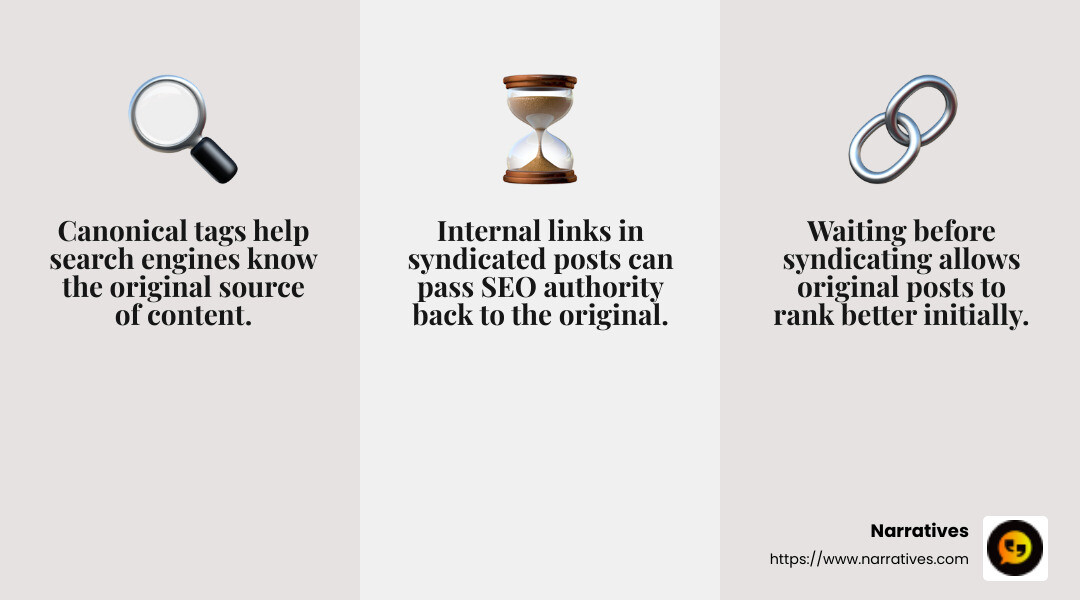Syndicate Your Blog: A Step-by-Step Guide to Boosting Visibility

Blog post syndication is a powerful way to increase the visibility of your content. In simple terms, it means sharing your original blog posts on other platforms to reach a broader audience. This tactic can help non-profits, social impact organizations, and advocacy-driven brands amplify their stories and mission without extra effort.
Here’s a quick overview:
- What it is: Republishing your blog content on other websites.
- Why it matters: Expands your reach and increases your content's visibility.
- Simple steps to start: Identify partners, tailor content, and manage SEO carefully.
Syndication not only makes your content work harder but also connects with new audiences eager to engage with your story. When done right, it opens doors to increased awareness, better engagement, and the potential for meaningful partnerships.

Blog post syndication terms to know:
Understanding Blog Post Syndication
Blog post syndication is all about giving your content a second life. It involves republishing your blog posts on different platforms to tap into new audiences. Think of it like airing a TV show rerun on a new network to reach more viewers.
What is Content Syndication?
At its core, content syndication means taking content from your website and sharing it elsewhere. This can include republishing blog posts, videos, or even podcasts. It's not limited to your website—you can syndicate on social media, other blogs, or platforms like Medium and dev.to.
Why Syndicate?
The primary goal is to boost visibility. By sharing your content on platforms with larger or different audiences, you increase the chances of your message being seen. For non-profits or organizations focused on social impact, this can mean more support and engagement for their causes.
SEO and Syndication
A common concern with syndication is its impact on SEO performance. If not done correctly, you risk duplicate content issues, which can harm your search engine rankings. But don't worry—there are ways to manage this.
Canonical Tags: Use these tags to signal search engines that your original post is the primary source. This helps preserve your SEO authority.
Timing: Wait a bit before syndicating. This allows your original post to gain traction and search engine recognition.
Platform Authority: Choose platforms with higher authority than your own. This can improve your content's visibility and potential backlink profile.
Internal Links: Include links in your syndicated posts that lead back to your original content. This can pass authority and bring readers to your site.

Real-World Impact
Scott Mathson, an SEO expert, highlights how content syndication can significantly boost a website's backlink profile. Over two years, he grew a site's backlinks from 200K to over 4.4 million by using syndication alongside other strategies. This shows the potential for syndication to improve your SEO performance when done right.
By understanding and implementing these strategies, you can ensure that your syndicated content not only reaches a broader audience but also strengthens your website's SEO performance.
Benefits of Blog Post Syndication
Blog post syndication offers several benefits that can significantly amplify your online presence. Let's explore some of the key advantages: brand awareness, backlinks, and audience reach.
Brand Awareness
Syndicating your blog content is like putting up billboards across the internet. When your articles appear on well-known platforms, they act as endorsements of your expertise. This can help establish your brand as a trustworthy source of information.
- Increased Visibility: By getting your content on platforms with established audiences, you introduce your brand to people who may have never encountered it before.
- Trust Building: When authoritative websites host your content, it lends credibility to your brand. Think of it as a seal of approval from a respected source.
Backlinks
Backlinks are the backbone of SEO, and content syndication is a powerful way to build them.
- Boost SEO Performance: Each time your content is republished, it often includes links back to your original site. These backlinks can improve your site's authority in the eyes of search engines.
- Example: Scott Mathson, an SEO expert, managed to grow a site's backlinks from 200K to over 4.4 million by leveraging syndication. This demonstrates the potential of syndication in enhancing a site's backlink profile.
Audience Reach
Reaching a broader audience is one of the primary goals of syndication. When done right, it places your content in front of different demographics and interest groups.
- New Readers: Syndication introduces your content to readers who wouldn't typically visit your site. This can lead to increased traffic and potential new followers.
- Engagement and Interaction: By appearing on platforms where your target audience spends their time, you increase the chances of meaningful engagement with your content.
Conclusion
By leveraging blog post syndication, you can significantly improve your brand's visibility, improve your SEO through valuable backlinks, and expand your audience reach. These benefits make syndication a strategy worth considering for anyone looking to maximize their content's impact.
Next, we'll explore the step-by-step process of how to syndicate your blog content effectively.
How to Syndicate Your Blog Content
Ready to get your blog content in front of more eyes? Let's walk through the steps to syndicate your blog content effectively.
Republish Content
When you republish content, you're sharing your existing blog posts on other platforms. This can be a quick way to reach new audiences without creating new content from scratch.
Start with High-Quality Content: Ensure your original content is well-written and valuable to your audience. It should address their pain points and provide actionable solutions.
Choose Content Wisely: Not all content is suitable for syndication. Focus on evergreen topics that have long-term value and appeal to a broad audience.
Syndication Partners
Finding the right syndication partners is key to a successful strategy. You want to connect with platforms that align with your brand and target audience.
Identify Potential Partners: Use search engines to find websites that already syndicate content. Phrases like "originally appeared on" or "republished with permission" can help you locate these platforms.
Pitch Your Content: Once you've identified suitable partners, reach out with a compelling pitch. Explain how your content can add value to their audience and include examples of your best-performing posts.
SEO Best Practices
When syndicating content, it's crucial to follow SEO best practices to avoid duplicate content issues and maintain your site's authority.
Use Canonical Tags: These tags tell search engines which version of your content is the original. This helps prevent duplicate content penalties and ensures your site gets the SEO credit it deserves.
Add Backlinks: Ensure your syndicated content includes links back to your original post. This not only drives traffic to your site but also boosts your domain's authority.
Track Results: Use tools like Google Analytics to monitor the performance of your syndicated content. Track referral traffic and engagement to understand how well your strategy is working.

By following these steps, you can effectively syndicate your blog content and expand your reach. Next, we'll compare free and paid syndication methods to help you decide which approach suits your needs best.
Free vs. Paid Syndication Methods
When it comes to blog post syndication, you have two primary paths: free and paid. Each has its own set of benefits and challenges, and choosing the right one depends on your goals and resources.
Free Syndication
Free syndication involves partnering with websites that will publish your content at no cost. This is a great option if you're looking to expand your reach without spending money.
Advantages:
- No Cost: The biggest perk is that it's free. You collaborate with partners who are willing to publish your content on their sites.
- Brand Exposure: Getting your content on well-known sites can boost your brand's visibility and credibility.
Challenges:
- Limited Opportunities: Not all platforms are open to free syndication partnerships, and the process often involves pitching ideas back and forth with editors.
- Varied Audience: These platforms often target diverse audiences, which can make it tough to attract qualified traffic.
Examples of Free Platforms:
- Business2Community
- Fast Company
- Lifehacker
Paid Syndication
Paid syndication involves paying platforms to distribute your content. This method can be more straightforward and offers more control over where and how your content appears.
Advantages:
- Targeted Reach: You can set your budget, choose your audience, and define campaign goals, similar to paid advertising.
- Prestigious Platforms: Services like Outbrain and Taboola can get your content featured on major sites like CNN and Bloomberg, enhancing brand image.
Challenges:
- Cost: Every click on your content can incur costs, making it potentially expensive.
- Ad-Like Appearance: Content may resemble ads, leading to "banner blindness," where users ignore elements that look like advertisements.
Content Distribution Networks
Both free and paid methods can use content distribution networks to streamline the syndication process. These networks connect you with a range of publishers, helping you reach broader audiences efficiently.
Key Considerations:
- SEO Impact: Free syndication may offer better SEO benefits due to natural backlinks, while paid options might not improve rankings if links are marked as "sponsored."
- Control Over Content: Paid platforms offer more control over where your content appears, but free platforms may require negotiations and approvals.
Choosing between free and paid syndication depends on your specific needs. If budget constraints are a concern, free syndication is a viable path. However, if you aim for rapid exposure on high-profile sites, investing in paid syndication could be worth it.
In the next section, we'll explore best practices for ensuring your syndicated content is both successful and effective.
Best Practices for Successful Syndication
When it comes to blog post syndication, ensuring your content is both successful and effective requires attention to a few key practices: canonical tags, avoiding duplicate content, and using internal links wisely.
Use Canonical Tags
Canonical tags are your best friend when syndicating content. They tell search engines which version of your content is the "official" one. This helps avoid confusion and ensures that your original post gets the credit it deserves in search results.
Here's what a canonical tag looks like:
<link rel="canonical" href="https://www.yourwebsite.com/original-article/" />By implementing these tags, you guide search engines to prioritize your original content over syndicated versions. This is crucial for maintaining your site's SEO performance.
Avoid Duplicate Content
Duplicate content is a common pitfall in syndication. When search engines encounter multiple versions of the same content, they might not know which one to rank, potentially leaving your original post unindexed.
To avoid this, always communicate with your syndication partners about the importance of canonical tags. Make sure they attribute your content properly and link back to your original post. This not only helps with SEO but also directs traffic back to your site.
Leverage Internal Links
Internal links are another powerful tool in your syndication strategy. When syndicating content, include links back to related articles or resources on your own website. This not only strengthens your site's backlink profile but also encourages readers to explore more of your content.
For example, if you're syndicating a post about digital marketing strategies, link back to other relevant articles on your site, like "The Basics of SEO" or "How to Master Social Media Marketing."
By following these best practices, you ensure that your syndicated content not only reaches a broader audience but also supports your SEO goals and drives traffic back to your original site.
In the next section, we'll address some frequently asked questions to further clarify the nuances of blog post syndication.
Frequently Asked Questions about Blog Post Syndication
What is the difference between syndication and guest posting?
Blog post syndication and guest posting might seem similar, but they serve different purposes. Syndication involves republishing your existing content on other platforms to reach a wider audience without creating new material. It's like giving your content a second life. Guest posting, on the other hand, requires writing new, original content specifically for another site. This is often used to build relationships and showcase expertise in a new space.
Think of syndication as recycling your best work, while guest posting is about creating fresh content for a new audience. Both methods can boost visibility, but they have distinct strategies and outcomes.
How can I avoid duplicate content issues?
Duplicate content can be a headache for SEO, but it's avoidable with a few key steps:
Use Canonical Tags: These tags signal to search engines which version of your content is the original. Ensure your syndicated posts include a canonical tag pointing to your original article.
Communicate with Partners: Make sure your syndication partners understand the importance of proper attribution and canonical tags. This helps maintain your content's SEO integrity.
Wait Before Syndicating: Allow some time for your original post to be indexed by search engines before syndicating. This ensures search engines recognize your site as the primary source.
By following these steps, you can sidestep the pitfalls of duplicate content and keep your SEO strategy intact.
What are the best platforms for syndicating content?
Choosing the right platform for syndication can significantly impact your content's reach and effectiveness. Here are some popular options:
Medium: A widely used platform that caters to a broad audience. It also allows you to add canonical links easily.
Dev.to: Great for tech-related content. It supports canonical tags, ensuring your original work gets the SEO credit.
DZone: Ideal for developers and tech enthusiasts, this platform offers a dedicated audience interested in technical content.
When selecting a platform, consider its audience and authority. The goal is to find a platform that aligns with your content's niche and improves your visibility.
In the next section, we'll explore the nuances of free vs. paid syndication methods and how they can fit into your content strategy.
Conclusion
At Narratives, we believe in the power of storytelling to transform communities and lift underrepresented voices. Blog post syndication is a vital tool in our strategy to amplify these stories and reach a broader audience. By republishing content, we help non-profits and purpose-driven organizations share their impact narratives far and wide, inspiring action and building trust.
Storytelling is at the heart of what we do. It's not just about sharing information; it's about creating connections and fostering empathy. Through our content syndication efforts, we aim to make these stories accessible to more people, ensuring that the voices of those making a difference are heard.
Partnering with non-profits allows us to highlight their incredible work and the communities they serve. By syndicating their stories, we help increase their visibility and support their mission. This approach aligns with our commitment to social impact and community-driven storytelling.
For those interested in learning more about how Narratives can help your organization boost visibility and share your story, we invite you to learn more about our services. Together, we can create a world where every story matters and every voice is heard.


